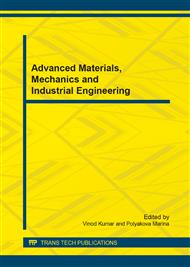p.265
p.271
p.276
p.281
p.288
p.294
p.298
p.304
p.309
Heat Dissipation Capacity of Heat Sink Assembly with/without Vortex Generators
Abstract:
In this research, numerical simulation is adopted to study the cooling characteristic of a bracket-type heat sink assembly. Analysis on thermal/fluid fields are used to justify the physical mechanisms inducing the excessive heat dissipation and temperature rise. In order to enhance the cooling capacity of the heat sink assembly, two types of vortex generator, flow-up and flow-down were used to create the turbulent flow for increasing the contact opportunitybetween fluid and plate fin.Also, thermal resistance is used to evaluate the cooling capacity of the heat sink assembly in this work. As a result, the numerical simulations show thatapparent reductions on source temperature (from 348.0K to 346.2K) and thermal resistance (from 0.266 K/W to 0.253 K/W) are observed for a 150W power input. Besides, significant improvement on the heat concentrated phenomenon anduniform temperature distribution were acquired after installing the vortex generators.Furthermore,a larger longitudinal flow was generated when the flow-up type vortex generator was mounted; therefore the temperature distribution is more uniform than that of the flow-downtype. Clearly, the cooling capacity of heat sink assemblyis enhanced since the fluid is guided to the heat concentrated area when theflow-down vortex generators are adopted.
Info:
Periodical:
Pages:
288-293
Citation:
Online since:
July 2014
Price:
Сopyright:
© 2014 Trans Tech Publications Ltd. All Rights Reserved
Share:
Citation:


